| Pages:
1
2
3
4
5
6
..
8 |
Magpie
lab constructor
    
Posts: 5939
Registered: 1-11-2003
Location: USA
Member Is Offline
Mood: Chemistry: the subtle science.
|
|
I have been seeing what copper(II) compounds I can make with root killer CuSO4*5H2O. I have made Cu(OH)2, CuO, Cu(OH)2*CuCO3, and Cu(OAc)2*H2O.
The Cu(OAc)2*H2O was made from my homemade cupric hydroxide using 10% acetic acid made up from GAA. Below is a picture of a few crystals, which have
a very dark color and smooth faces. They are prismatic and 3-4 mm wide. The end of the pestle shows the color of the crystals when ground. In the
bottle is the basic cupric carbonate.
What has got me puzzled is the blue color of the carbonate and the acetate. I was expecting green for both. Brauer calls the carbonate "green copper
carbonate", or "malachite." YT2095's acetate crystals were dark green in accordance with my CRC handbook.
(However, I have an abstract of a 1940's Russian journal article that says the acetate crystals will be dark blue.)
So, does anyone have an explanation for these apparent color discrepancies? What have been your experiences?
[Edited on 3-6-2008 by Magpie]
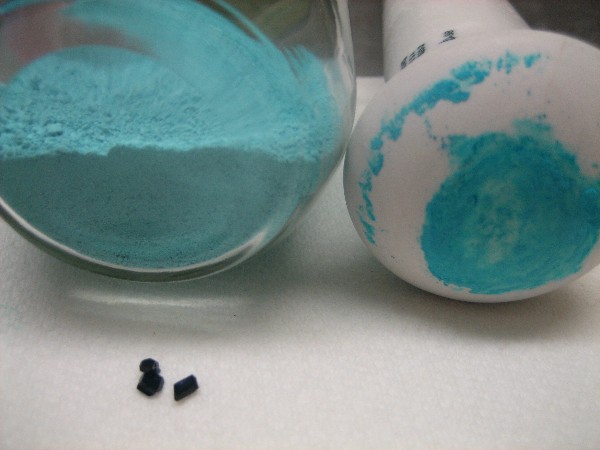
|
|
|
woelen
Super Administrator
        
Posts: 8011
Registered: 20-8-2005
Location: Netherlands
Member Is Offline
Mood: interested
|
|
This is exactly what I would expect for cupric acetate. I made cupric acetate as well and what I made is a very dark green/blue crystal mass, which on
grinding becomes exactly as what you show.
This is a very common effect. When dark material is ground, then its appearance becomes lighter. A similar thing I noticed with anhydrous CuCl2. This
is dark chocolate brown when in the form of somewhat larger crystals, but when it is finely powdered, it becomes more like mustard/yellow.
|
|
|
12AX7
Post Harlot
    
Posts: 4803
Registered: 8-3-2005
Location: oscillating
Member Is Offline
Mood: informative
|
|
Hmm, azurite is blue carbonate. Maybe it wasn't hot enough? I recall azurite decomposes to malachite over time (which is why some blue colors look
green on old murals, frescoes, etc.). Heat, I should think, should produce the thermodynamically favored product.
Tim
|
|
|
Magpie
lab constructor
    
Posts: 5939
Registered: 1-11-2003
Location: USA
Member Is Offline
Mood: Chemistry: the subtle science.
|
|
Woelen says:
| Quote: |
I made cupric acetate as well and what I made is a very dark green/blue crystal mass, which on grinding becomes exactly as what you show.
|
Well, thank you, this makes me feel better. I would like to hear from YT2095 to see what color his ground acetate crystals are.
Actually I made an error in the post above. I grew my crystals from homemade Cu(OH)2 instead of the basic carbonate.
I also have a batch growing using the basic carbonate and 10% acetic acid as per YT2095. I will have to wait to see what crystals I get.
I am also now firing some basic carbonate at 650C in my muffle furnace to get some pure CuO. Then I will try to grow acetate crystals from that, also
using 10% acetic acid.
12AX7, I also thought I had made azurite but I don't think this will happen unless you use CO2 at a few atmospheres (per Brauer). If you add too
much Na2CO3 I think it just washes out during the filtration/washing step for making the malachite.
I even tried to way undershoot the carbonate to make sure I had malachite. But in this case I think you just wash out the excess CuSO4 during the
filtration/washing step. So, either way you get Cu(OH)2*CuCO3. As I suspected the product in the undershoot experiment was the same robin-egg blue.
I fired some of my basic carbonate at 650C and then weighed it. Comparing it to its original weight I calculated a carbonate/hydroxide ratio of 1.08.
[Edited on 3-6-2008 by Magpie]
|
|
|
YT2095
International Hazard
    
Posts: 1091
Registered: 31-5-2003
Location: Just left of Europe and down a bit.
Member Is Offline
Mood: within Nominal Parameters
|
|
certainly, here you go:

the far left is the crystaline copper acetate, in the middle is the same but ground up, and the far right is my copper carbonate as Azurite.
with the carbonate, if I`m going to have the lid off for any length of time, I fill the jar with CO2 when I`m finished and put it back on the shelf,
it keeps nicely that way.
\"In a world full of wonders mankind has managed to invent boredom\" - Death
Twinkies don\'t have a shelf life. They have a half-life! -Caine (a friend of mine)
|
|
|
Magpie
lab constructor
    
Posts: 5939
Registered: 1-11-2003
Location: USA
Member Is Offline
Mood: Chemistry: the subtle science.
|
|
Yes! Thank you very much YT2095! Although it seems your crystals distinctly have a green tint, when ground the light blue color is the same as mine
and Woelen's.
Did you buy or make your azurite? If you bought it was it called "azurite" by the seller?
|
|
|
YT2095
International Hazard
    
Posts: 1091
Registered: 31-5-2003
Location: Just left of Europe and down a bit.
Member Is Offline
Mood: within Nominal Parameters
|
|
I made it myself from scrap copper that I save.
when I get enough I dissolve the lot in nitric acid, filter, and then react with K2CO3 soln to make the carbonate.
it`s worth pointing out that you must keep this mixture stirring all the time you add the K2CO3 soln, eventualy you reach a point where the color of
the ppt will change you can end up with either the Azurite blue or the malachite green depending how much you add.
I stopped at the Blue.
\"In a world full of wonders mankind has managed to invent boredom\" - Death
Twinkies don\'t have a shelf life. They have a half-life! -Caine (a friend of mine)
|
|
|
Magpie
lab constructor
    
Posts: 5939
Registered: 1-11-2003
Location: USA
Member Is Offline
Mood: Chemistry: the subtle science.
|
|
That's very interesting YT2095. I made my basic cupric carbonate per Brauer using root killer CuSO4*5H2O and washing soda Na2CO3. I haven't tried
making any copper nitrate or using it as a precursor. Now I'm tempted to do that.
I have had some unexpected things happen while working from the CuSO4*5H2O. Several procedures I have seen specify heating cupric hydroxide to 60C or
even 70C. I have found that if I get anywhere near 60C any cupric hydroxide I have will turn to the black CuO. So I stay away from any heating.
Another thing I have learned is that (for me at least) it is not all that easy to make cupric acetate in nice large crystals. So far the only success
I have had is with Cu(OH)2 as precursor (in turn made from CuSO4*5H2O). With the other tries I just get the hundreds of tiny blue dots like I showed
earlier in this thread.
My original goal was to find the most efficient way to make nice big crystals of cupric acetate monohydrate using root killer CuSO4*5H2O as the
precursor. I selected this precursor as it is reasonably cheap and I just happened to have about 1kg on hand.
|
|
|
YT2095
International Hazard
    
Posts: 1091
Registered: 31-5-2003
Location: Just left of Europe and down a bit.
Member Is Offline
Mood: within Nominal Parameters
|
|
copper sulphate and washing soda will work just as well as my method, the only reason I do it the way I do is because nitric will dissolve copper
metal in minutes without any fuss (and I have plenty of it), and I use K2CO2 because if I used the carbonate in any pyro mixture I wouldn`t want Any
sodium ions to contaminate the color.
you still have to wash it very well after making it though.
as for the acetate you`l probably have to make a larger and more concentrated amount, and rather than crystalise this in a shallow dish try something
a little taller and evaporate more slowly, it should give you larger crystals.
here`s another nice copper salt, perfectly clear blue, but lighter than copper sulphate.

it`s Copper Malate, simply made buy adding copper carbonate to malic acid soln and crystalising, it`s a little more difficult than some salts as it
tends to get very viscous as it evaporates and can form a skin on the top, a bit like making sugar crystals.
the color is quite nice though.
\"In a world full of wonders mankind has managed to invent boredom\" - Death
Twinkies don\'t have a shelf life. They have a half-life! -Caine (a friend of mine)
|
|
|
Magpie
lab constructor
    
Posts: 5939
Registered: 1-11-2003
Location: USA
Member Is Offline
Mood: Chemistry: the subtle science.
|
|
| Quote: |
as for the acetate you`l probably have to make a larger and more concentrated amount, and rather than crystalise this in a shallow dish try something
a little taller and evaporate more slowly, it should give you larger crystals.
|
Yes, I have been using evaporating dishes lately instead of the kitchenware shown in my first post. As you say this gives a slower evaporation rate.
It seems patience (several days) is a virtue needed for growing copper acetate.
My attempt at growing the acetate crystals from copper carbonate was a failure. But my attempt using fired CuO seems to be progressing well. I
placed a crystal from earlier growing in the dish as a seed crystal. It is growing! When it has finished I'll post a picture.
|
|
|
Magpie
lab constructor
    
Posts: 5939
Registered: 1-11-2003
Location: USA
Member Is Offline
Mood: Chemistry: the subtle science.
|
|
Here's a picture of the big crystal of cupric acetate monohydrate grown from a seed crystal. Next to it are the normal sized crystals that started on
their own.
These were grown from unfired CuO rather than fired CuO as I reported earlier. I couldn't get the fired CuO to dissolve.
Also shown is the blue homemade basic cupric carbonate compared to the green pottery grade of basic cupric carbonate. This color difference really
puzzles me.
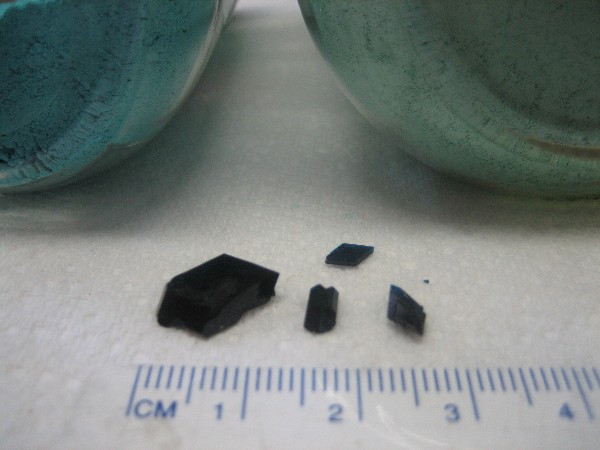
|
|
|
bereal511
Hazard to Others
  
Posts: 162
Registered: 9-8-2005
Location: Madison, WI
Member Is Offline
Mood: No Mood
|
|
Just a conjecture, but perhaps your homemade basic cupric carbonate contains a larger portion of cupric carbonate than cupric hydroxide, rather than
the 1:1 of your pottery grade (Is pottery grade malachite? I'm not sure). The powder has a more blue hue akin to YT2095's azurite than the greener
malachite. How did you make it?
[Edited on 8-6-2008 by bereal511]
As an adolescent I aspired to lasting fame, I craved factual certainty, and I thirsted for a meaningful vision of human life -- so I became a
scientist. This is like becoming an archbishop so you can meet girls.
-- Matt Cartmill
|
|
|
chemoleo
Biochemicus Energeticus
    
Posts: 3005
Registered: 23-7-2003
Location: England Germany
Member Is Offline
Mood: crystalline
|
|
I'm impressed about the CuAc2 crystal. Can you manage to get a better shot, with better colour accuracy? Or is it really that dark?? Is it transparent
to light at all?
Never Stop to Begin, and Never Begin to Stop...
Tolerance is good. But not with the intolerant! (Wilhelm Busch)
|
|
|
UnintentionalChaos
International Hazard
    
Posts: 1454
Registered: 9-12-2006
Location: Mars
Member Is Offline
Mood: Nucleophilic
|
|
Chemeleo- having grown CuOAc2 myself, I can tell you that it is intensely dark colored. A bright light behind it will illuminate the thinnest edges,
while the rest remains dark. I have also tried to photograph them....they are black with a tinge of dark blue-green and shiny smooth crystal faces.
As for the discussion on malachite/azurite, I have left blue copper carbonate in a funnel over a flask that was slowly generating some CO2 and thought
nothing of it, but the next morning, the blue copper carbonate (still wet) had turned green in the little round patch over the neck of the funnel.
Maybe something like this can be useful in an intentional synthesis of malachite.
Department of Redundancy Department - Now with paperwork!
'In organic synthesis, we call decomposition products "crap", however this is not a IUPAC approved nomenclature.' -Nicodem
|
|
|
Magpie
lab constructor
    
Posts: 5939
Registered: 1-11-2003
Location: USA
Member Is Offline
Mood: Chemistry: the subtle science.
|
|
from UnintentionalChaos:
| Quote: |
Chemeleo- having grown CuOAc2 myself, I can tell you that it is intensely dark colored. A bright light behind it will illuminate the thinnest edges,
while the rest remains dark. I have also tried to photograph them....they are black with a tinge of dark blue-green and shiny smooth crystal faces.
|
I couldn't say it better myself. When I look at my crystals in the picture above I can almost say I see a very dark green hint. But when looking at
a thin edge in good light I see a gleam of blue.
Bereal I also thought that the green material just had less CuCO3 vs the blue. This is the conclusion I got when comparing the procedures in Brauer.
But when I fired samples of the two grades, then reweighed, my results supported an opposite conclusion. The ratio of CuCO3/Cu(OH)2 in my blue
product is 1.08, in the green pottery product it is 1.24!
The first method in Brauer, p. 1024, (Green Cupric Carbonate), in the forum library, is what I used to make my blue carbonate. Starting material was
CuSO4*5H2O.
Now the experience of UnintentionalChaos with CO2 applied to wet blue carbonate also supports the conclusion that the more carbonate the more green.
Again, this is opposite to Brauer.
When you see the green patina of copper exposed to the elements as in a copper roof or work of art it is usually green. This would also indicate an
exposure to CO2. An example can be seen in the picture below which is of a piece of copper sheet metal on a very old wind chime in my backyard.
[Edited on 8-6-2008 by Magpie]
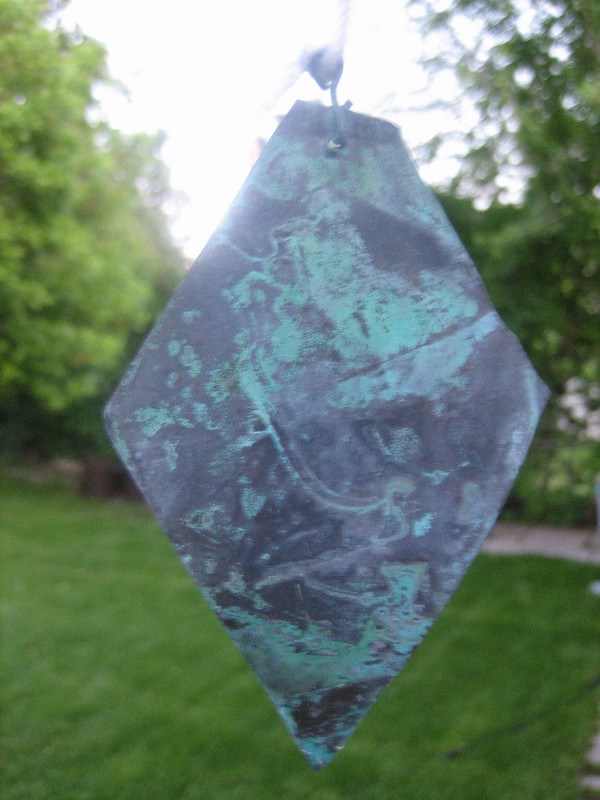
|
|
|
woelen
Super Administrator
        
Posts: 8011
Registered: 20-8-2005
Location: Netherlands
Member Is Offline
Mood: interested
|
|
As a side-walk, I tried to make copper propionate from basic copper carbonate. I mixed 1 ml of propionic acid with 2 ml of water and added some basic
copper carbonate. The problem I am running into is that the material hardly dissolves. It only produces CO2 very slowly, even when heated to near
boiling. The solution, however, gets a beautiful deep green/blue color, even when only a small fraction of all basic copper carbonate dissolves. It is
interesting to investigate the differences between acetate and propionate.
I'll leave the solution for a few days, maybe the basic copper carbonate does dissolve, but very slowly. I have the impression that the color of the
propionate resembles that of the acetate, but more intense and somewhat more green. If I get any crystals of this compound, then I'll post pictures in
this thread.
|
|
|
Magpie
lab constructor
    
Posts: 5939
Registered: 1-11-2003
Location: USA
Member Is Offline
Mood: Chemistry: the subtle science.
|
|
That's an interesting project Woelen and I look forward to your picture. I wonder if it will form the same type of structure, which is quite
remarkable, as you show on your website for the acetate.
When I was collecting procedures for cupric acetate I noticed that those that did specify an acid concentration specified 8-10%. Maybe that would
help in your dissolution process. (Acetic acid being a weak organic acid has higher ionization in the lower concentrations - maybe this helps.)
|
|
|
woelen
Super Administrator
        
Posts: 8011
Registered: 20-8-2005
Location: Netherlands
Member Is Offline
Mood: interested
|
|
The propionate now is drying, it looks quite a lot like the acetate.
I now prepared the following salts (fine crystal mass):
1) copper acetate
2) copper monochloroacetate
3) copper trichloroacetate
4) copper propionate
I did a nice observation. In solution, only copper acetate and copper propionate seem to be heavily coordinated. The solution is darker than e.g. a
copper sulfate solution of similar copper concentration, and the color is more greenish.
Copper monochloroacetate is not greenish at all in solution, it is more like a concentrated solution of copper sulfate. The picture below shows a
solution of copper acetate and copper monoacetate.
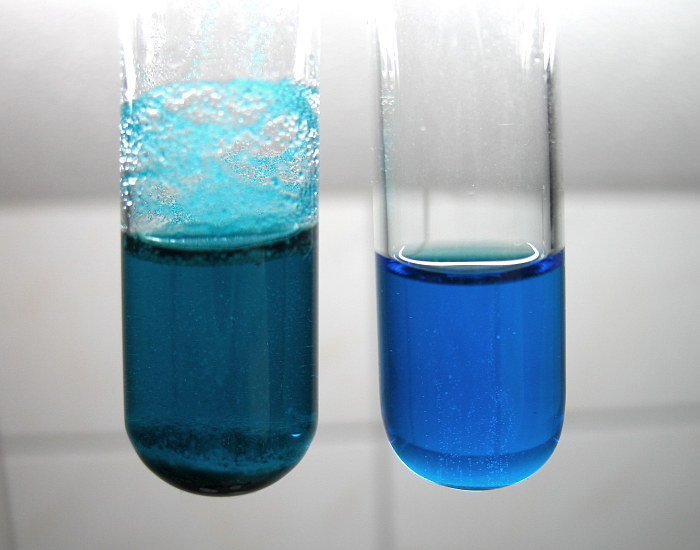
A solution of copper trichloroacetate looks the same as a solution of copper monochloroacetate, plain blue copper ions
When the solid is made, then, however, the monochloroacetate becomes a coordination complex, the solid looks more like plain copper acetate. The
trichloroacetate, also in solid form is not like the plain acetate anymore. It is bright blue like copper sulfate or copper nitrate. The picture below
shows from left to right the plain acetate, the monochloroacetate and the trichloroacetate.
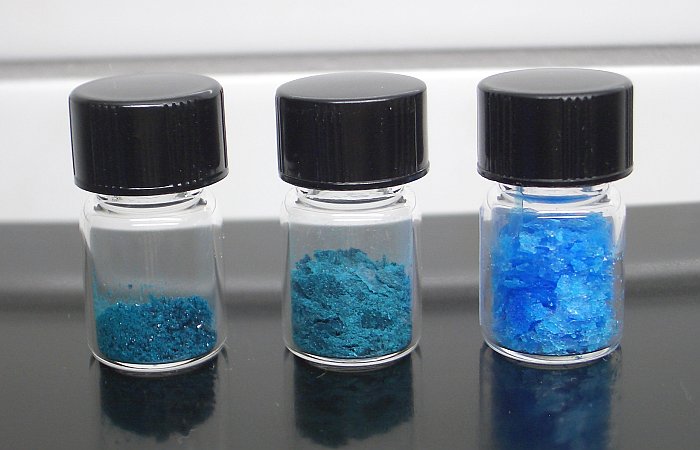
So, it seems as if the chlorine on the acetate ion makes coordination with the copper ion weaker (more labile). The monochloroacetate still is
coordinated in the solid, but in solution the complex dissociates and a plain blue aqua complex is formed. The trichloroacetate is not coordinated at
all, the solid also seems to contain a simple hydrated copper ion.
All three copper acetates are non-hygroscopic. They can easily be dried and form a nice dry non-sticky powder.
The solution of the propionate resembles a solution of a plain acetate.
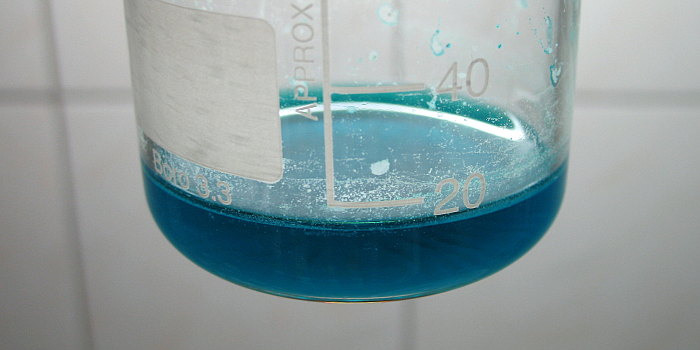
When I have the dry solid copper propionate, then I'll make a nice write-up in a web page, but here you already have a few pics.
[Edited on 12-6-08 by woelen]
<!-- bfesser_edit_tag -->[<a href="u2u.php?action=send&username=bfesser">bfesser</a>: fixed
broken image(s)]
[Edited on 7.1.14 by bfesser]
|
|
|
Magpie
lab constructor
    
Posts: 5939
Registered: 1-11-2003
Location: USA
Member Is Offline
Mood: Chemistry: the subtle science.
|
|
Very interesting woelen. It seems that the Cl atom(s) are disrupting the resonance at the carbonyl end of the molecule. Or perhaps it could be a
steric hindrance effect.
|
|
|
12AX7
Post Harlot
    
Posts: 4803
Registered: 8-3-2005
Location: oscillating
Member Is Offline
Mood: informative
|
|
Should be the inductive effect at work. Roughly it should be as many times a weaker ligand as it is a stronger acid.
Tim
|
|
|
woelen
Super Administrator
        
Posts: 8011
Registered: 20-8-2005
Location: Netherlands
Member Is Offline
Mood: interested
|
|
Here is the webpage about all the different compound I made. I also added lactate and formiae. The inductive effect, as described by 12AX7 indeed can
explain all the observations.
http://woelen.homescience.net/science/chem/exps/copper_aceta...
Also have a look at the nice crystal I obtained with the formiate. There is a link inside the copper acetates page.
<!-- bfesser_edit_tag -->[<a href="u2u.php?action=send&username=bfesser">bfesser</a>: fixed
external link(s)]
[Edited on 7.1.14 by bfesser]
|
|
|
indigofuzzy
Hazard to Others
  
Posts: 145
Registered: 1-10-2006
Location: DarkCity, Bay of Rainbows, Moon
Member Is Offline
Mood: Distilled
|
|
Some patiently grown (took almost a month) Copper Acetate crystals:
[img]http://farm4.static.flickr.com/3056/2652215294_87467270bf.jpg?v=0[/img]
[img]http://farm4.static.flickr.com/3243/2652215246_780282f73e.jpg?v=0[/img]
The grid squares are 0.10 inches (2.54 mm)
|
|
|
Magpie
lab constructor
    
Posts: 5939
Registered: 1-11-2003
Location: USA
Member Is Offline
Mood: Chemistry: the subtle science.
|
|
Vera nice.  What were your starting materials? What color are they? I.e., more
blue than green, more green than blue, or blue-green, etc. (I'm thinking the camera may distort this color somewhat.) What were your starting materials? What color are they? I.e., more
blue than green, more green than blue, or blue-green, etc. (I'm thinking the camera may distort this color somewhat.)
|
|
|
YT2095
International Hazard
    
Posts: 1091
Registered: 31-5-2003
Location: Just left of Europe and down a bit.
Member Is Offline
Mood: within Nominal Parameters
|
|
wow, those are Beautiful specimens, Well Done! 
whilst on the subject of crystals, has anyone ever seen crystals growing on Top of the liquid layer?
I have some sodium oxalate that I`v made for use later, and am now letting it crystalise.
it has formed a "raft" like island on the top of the liquid layer and on this "Island" crystals are growing Upwards on it like little mountains.
I`v seen a skin form of certain solns before, but I`v never seen this happen.
[Edited on 10-7-2008 by YT2095]
\"In a world full of wonders mankind has managed to invent boredom\" - Death
Twinkies don\'t have a shelf life. They have a half-life! -Caine (a friend of mine)
|
|
|
chemoleo
Biochemicus Energeticus
    
Posts: 3005
Registered: 23-7-2003
Location: England Germany
Member Is Offline
Mood: crystalline
|
|
That happens all the time in my experience....as long as you allow evaporation long enough (i.e. weeks)!
Usually the 'rafts' sink once they are to heavy, just make sure they don't fall onto your dangling seed crystals below otherwise you'll have the raft
growing into the seed crystals!
I'm impressed about the CuAc2 crystals! How about you break of one crystal of the crystal mass, and grow that individually? Would love to see the
'space group' of it, and a bigger version!
[Edited on 10-7-2008 by chemoleo]
Never Stop to Begin, and Never Begin to Stop...
Tolerance is good. But not with the intolerant! (Wilhelm Busch)
|
|
|
| Pages:
1
2
3
4
5
6
..
8 |